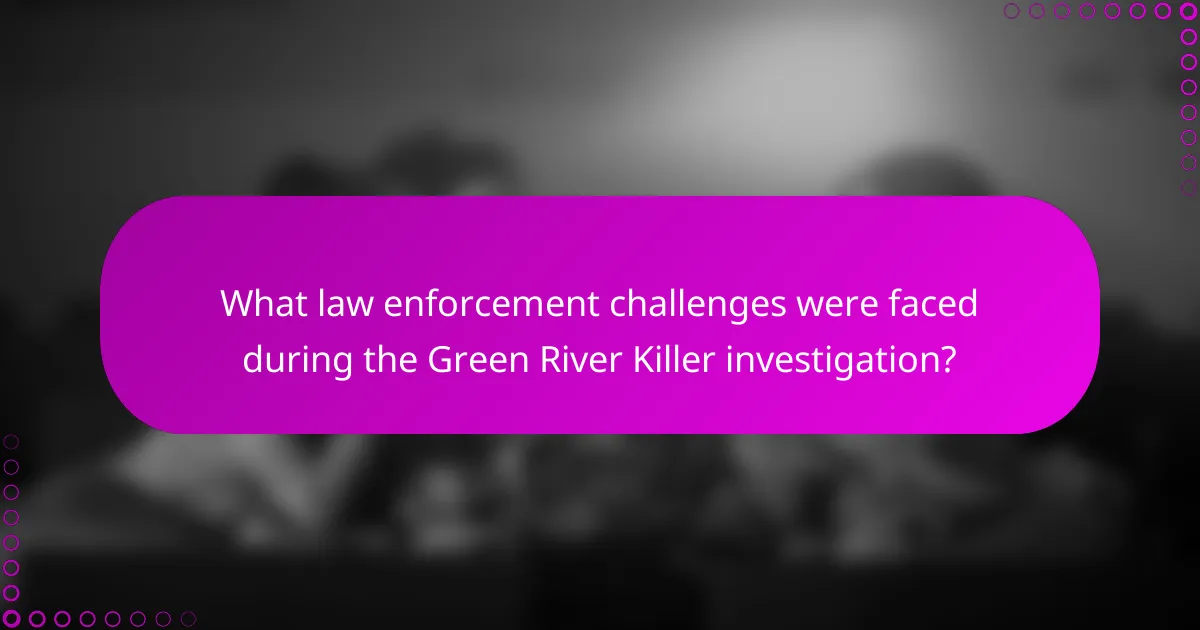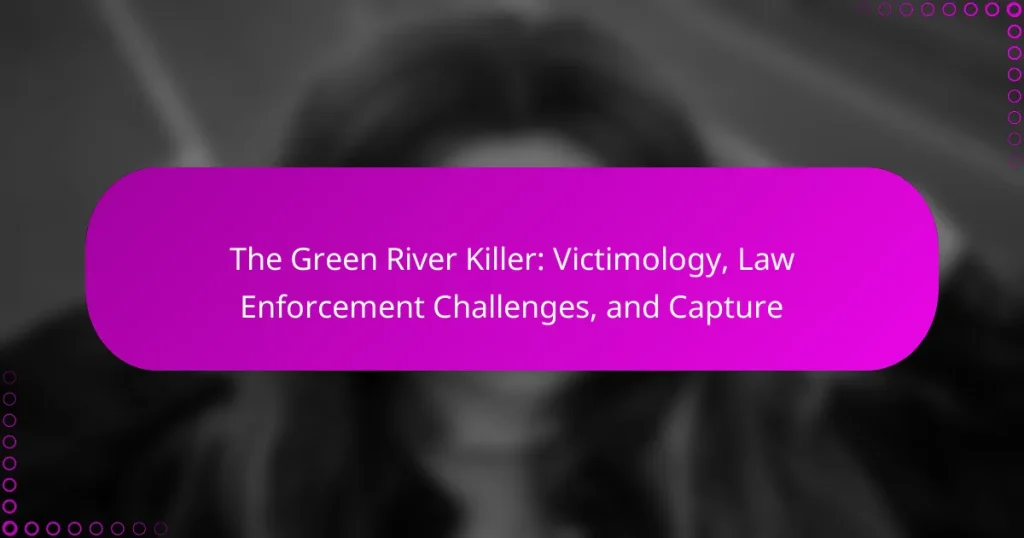The Green River Killer case involves a series of murders committed by Gary Ridgway in Washington State during the 1980s and 1990s, targeting vulnerable women, particularly sex workers. Ridgway’s criminal activities resulted in at least 49 confirmed deaths, prompting a complex investigation that faced numerous challenges, including the high number of victims and limitations in forensic technology. The case garnered significant public attention and pressure on law enforcement, ultimately leading to Ridgway’s arrest in 2001 through DNA evidence that linked him to the crimes. His confession revealed a chilling account of 71 murders, solidifying his status as one of the most notorious serial killers in U.S. history. This article explores the victimology, law enforcement challenges, and the eventual capture of the Green River Killer.

What is the Green River Killer case?
The Green River Killer case refers to a series of murders committed by Gary Ridgway in Washington State during the 1980s and 1990s. Ridgway targeted vulnerable women, often [censured] workers, leading to the deaths of at least 49 victims. The case gained notoriety due to the high number of victims and the challenges faced by law enforcement in capturing the killer. Ridgway was arrested in 2001 after DNA evidence linked him to the crimes. He later confessed to the murders, providing details that helped locate several bodies. The case remains one of the most infamous serial killer investigations in U.S. history.
Who were the victims of the Green River Killer?
The victims of the Green River Killer were primarily young women, many of whom were involved in [censured] work or had a history of substance abuse. The confirmed victims numbered 49, with the majority found in the Green River area of Washington state. The first known victim was Wendy Lee Coffield, abducted in 1982. Other identified victims include Margaret Hedrick, Opal Mills, and Kimmy Kwan. Most victims were reported missing between 1982 and 1984. The killer targeted vulnerable individuals, often preying on those with limited support systems. The case highlighted systemic issues surrounding the treatment of marginalized women. The remains of many victims were discovered in remote areas, leading to extensive law enforcement challenges in the investigation.
What characteristics defined the victims?
The victims of the Green River Killer were primarily young women. Most were aged between 15 and 24 years old. They often had a history of vulnerability, including issues with substance abuse or involvement in [censured] work. Many victims were reported as missing from marginalized communities. The majority were from the Seattle area, particularly King County. Several victims were identified as runaways or had unstable living conditions. This demographic profile reflects the killer’s targeting of individuals who were less likely to be reported missing immediately. The characteristics of the victims highlight systemic issues in society regarding the safety of vulnerable populations.
How did the victims’ backgrounds influence the investigation?
The victims’ backgrounds significantly influenced the investigation into the Green River Killer. Many victims were vulnerable individuals, often involved in [censured] work or substance abuse. This made them less likely to be reported missing promptly. Law enforcement initially faced challenges in prioritizing these cases due to societal biases regarding the victims’ lifestyles. The backgrounds of the victims led to a perception that their disappearances were less urgent. This hindered the investigation’s progress in its early stages. Additionally, the lack of resources allocated to cases involving marginalized individuals further complicated the investigation. Ultimately, understanding the victims’ backgrounds was crucial in forming a comprehensive profile of the killer and refining investigative strategies.
What were the key events in the Green River Killer investigation?
The Green River Killer investigation involved several key events. The case began in 1982 with the discovery of multiple bodies in the Green River near Seattle. Law enforcement identified the victims as women, many of whom were involved in [censured] work. In 1983, the task force was established to investigate the murders. The investigation faced challenges due to a lack of physical evidence and the transient nature of the victims. In 2001, DNA evidence linked Gary Ridgway to the murders. Ridgway was arrested in 2001 and later confessed to killing 71 women. He was sentenced to life in prison without parole in 2003.
How did the investigation evolve over time?
The investigation into the Green River Killer evolved significantly over time. Initially, law enforcement focused on the disappearance of women in the Seattle area. Early efforts involved searching for missing persons and interviewing potential witnesses. As bodies were discovered in the Green River, the investigation shifted to a homicide case. In 1984, the task force was established to coordinate efforts among multiple agencies. Advances in forensic science, including DNA analysis, transformed investigative techniques in the late 1980s. The investigation faced challenges, including public pressure and resource constraints. In 2001, Gary Ridgway was arrested after DNA evidence linked him to the crimes. His confession in 2003 provided crucial insights into the investigation’s trajectory. The evolution of the investigation reflects changing methodologies and the integration of technology in criminal investigations.
What were the major breakthroughs in the case?
The major breakthroughs in the Green River Killer case include the identification of Gary Ridgway as the primary suspect. DNA evidence collected from victims played a crucial role in this identification. In 2001, law enforcement utilized DNA testing to link Ridgway to several crime scenes. This marked a significant advancement in forensic science at the time. Additionally, Ridgway’s eventual confession in 2003 provided critical information about the locations of victims and his methods. His cooperation with authorities led to the recovery of remains that had been previously undiscovered. Each of these breakthroughs contributed to a more comprehensive understanding of the case and ultimately facilitated justice for the victims.

What law enforcement challenges were faced during the Green River Killer investigation?
Law enforcement faced numerous challenges during the Green River Killer investigation. The sheer number of victims complicated the case. Over 49 bodies were discovered, leading to difficulties in identifying remains. The investigation spanned several years, creating gaps in evidence. Limited forensic technology at the time hindered analysis of crime scenes. Additionally, the killer’s ability to evade capture created frustration among investigators. Public pressure for results intensified as the case progressed. Coordination among multiple law enforcement agencies proved challenging. These factors collectively complicated efforts to apprehend the Green River Killer.
What obstacles did law enforcement encounter?
Law enforcement encountered several obstacles during the investigation of the Green River Killer. One major challenge was the sheer number of victims, with over 49 bodies discovered, complicating the investigation. The lack of reliable forensic technology in the 1980s hindered evidence collection and analysis. Additionally, the transient lifestyle of many victims made it difficult to establish connections and identify them. Law enforcement also faced public pressure and media scrutiny, which added to the stress of the investigation. Furthermore, the region’s geography, including dense forests and waterways, complicated search efforts. These factors collectively delayed the capture of the killer, who evaded law enforcement for years.
How did public perception impact the investigation?
Public perception significantly influenced the investigation of the Green River Killer. It created pressure on law enforcement to solve the case quickly. Increased media coverage heightened public interest and scrutiny. This led to a demand for transparency and updates from investigators. Public fear and outrage also prompted community involvement in the search for victims. Additionally, misinterpretations of evidence by the public sometimes complicated the investigation. Ultimately, public perception shaped the narrative surrounding the case and affected police strategies.
What limitations in technology hindered the investigation?
Technological limitations that hindered the investigation of the Green River Killer included inadequate forensic tools. During the 1980s and early 1990s, DNA analysis was not as advanced as it is today. Law enforcement lacked access to comprehensive databases for matching DNA profiles. Additionally, the technology for tracking and analyzing geographic patterns of crime was rudimentary. Communication systems among agencies were inefficient, leading to delays in information sharing. These technological shortcomings contributed to challenges in identifying and apprehending the suspect.
How did law enforcement collaborate with other agencies?
Law enforcement collaborated with other agencies through task forces and information sharing. They formed a multi-agency task force that included local, state, and federal law enforcement. This collaboration allowed for a centralized approach to investigate the Green River Killer. Agencies shared resources, intelligence, and forensic evidence. The FBI provided behavioral analysis and criminal profiling expertise. Local police departments contributed case files and victim information. This cooperation was essential in coordinating efforts across jurisdictions. The collaboration ultimately led to significant breakthroughs in the investigation.
What role did federal agencies play in the investigation?
Federal agencies played a crucial role in the investigation of the Green River Killer case. The FBI provided behavioral analysis and profiling expertise. They assisted local law enforcement in understanding the psychological patterns of the killer. Additionally, federal agencies facilitated the sharing of information across state lines. This coordination was essential due to the multiple jurisdictions involved. The FBI’s Violent Criminal Apprehension Program (ViCAP) helped identify patterns in similar cases. Federal resources also supported forensic analysis of evidence collected from crime scenes. Overall, federal agencies enhanced the investigation’s effectiveness through collaboration and expertise.
How did local law enforcement strategies adapt throughout the case?
Local law enforcement strategies adapted by increasing collaboration and utilizing advanced technology. Initially, they focused on traditional investigative techniques. As the case progressed, they formed task forces to pool resources and expertise. They also began to employ forensic science and profiling methods to identify patterns. The introduction of DNA analysis in the 1980s marked a significant shift in their approach. This allowed for more accurate linking of evidence to suspects. Additionally, they engaged in community outreach to gather information from the public. The combination of these strategies ultimately led to the successful capture of the Green River Killer.

How was the Green River Killer ultimately captured?
The Green River Killer was ultimately captured in 2001 through DNA evidence. Gary Ridgway, the suspect, was linked to the murders after a DNA sample matched evidence collected from the crime scenes. Law enforcement used genetic testing to identify Ridgway as a prime suspect. He was arrested after a lengthy investigation that began in the 1980s. Ridgway confessed to killing 71 women, making him one of the most prolific serial killers in U.S. history. His capture marked a significant breakthrough in a case that had remained unsolved for decades.
What led to the arrest of Gary Ridgway?
Gary Ridgway was arrested due to his connection to the Green River murders. DNA evidence linked him to the crime scene. Law enforcement used genetic material from the victims to identify him. Ridgway had previously denied involvement in the murders. His arrest occurred in 2001 after a long investigation. He confessed to killing 71 women over several years. This confession provided closure for many families. Ridgway’s case highlighted significant challenges in forensic science and victim identification.
What evidence was pivotal in securing his arrest?
DNA evidence was pivotal in securing his arrest. Investigators collected samples from crime scenes linked to the Green River Killer. These samples were analyzed and matched to Gary Ridgway’s DNA. The match provided concrete proof of his involvement in the murders. Additionally, Ridgway’s own statements during interviews corroborated the evidence. His confessions further solidified the case against him. This combination of DNA evidence and confessions led to his eventual arrest in 2001.
How did Ridgway’s confession impact the case?
Ridgway’s confession significantly impacted the case by providing crucial evidence that led to his conviction. It confirmed his identity as the Green River Killer, responsible for numerous murders. His detailed admissions allowed law enforcement to connect him to the victims more definitively. The confession also facilitated the recovery of remains and the identification of victims. This information was vital in building a comprehensive case against him. Ridgway’s cooperation resulted in a plea deal, which ultimately saved the state resources on a lengthy trial. His confession also shed light on the motivations behind his crimes, enhancing understanding of the case.
What were the legal outcomes following his capture?
The legal outcomes following the capture of the Green River Killer, Gary Ridgway, included multiple convictions for murder. In 2003, he pleaded guilty to 49 counts of murder. This plea deal resulted in a life sentence without the possibility of parole. Ridgway’s cooperation with law enforcement led to the recovery of several victims’ remains. His case highlighted challenges in forensic evidence and victim identification. The legal proceedings also included civil lawsuits from victims’ families. These outcomes underscored the long-term impact of his crimes on the community.
What charges were brought against Gary Ridgway?
Gary Ridgway was charged with multiple counts of murder. He was convicted of killing 49 women in Washington State. These crimes occurred during the 1980s and 1990s. Ridgway is known as the Green River Killer. His charges included aggravated murder, which is a serious offense. In 2003, he pleaded guilty to these charges. Ridgway’s confessions revealed details about the murders. This led to his life sentence without the possibility of parole.
How did the legal proceedings unfold in court?
The legal proceedings in the case of the Green River Killer, Gary Ridgway, unfolded through a series of court appearances and legal strategies. Ridgway was arrested in 2001 after DNA evidence linked him to several murders. In 2003, he pleaded guilty to 49 counts of murder as part of a plea deal to avoid the death penalty. The plea agreement required him to provide information on the locations of the victims’ remains. His sentencing occurred in 2003, resulting in a life sentence without parole. The court proceedings were marked by extensive media coverage and public interest due to the nature of the crimes.
What lessons can be learned from the Green River Killer case?
The Green River Killer case teaches important lessons about victimology and law enforcement response. It highlights the vulnerabilities of marginalized communities, particularly [censured] workers. The case underscores the need for law enforcement to prioritize investigations involving vulnerable populations. Effective communication between agencies can enhance investigative efforts. The importance of utilizing forensic technology in solving cold cases is evident. It also illustrates the necessity for community engagement in crime prevention. Lastly, the case emphasizes the significance of mental health support for law enforcement personnel involved in traumatic investigations.
What improvements have been made in law enforcement practices since the case?
Law enforcement practices have significantly improved since the Green River Killer case. Enhanced training programs for officers now focus on victimology and behavioral analysis. Technology adoption, such as DNA profiling and digital databases, has accelerated evidence processing. Interagency collaboration has strengthened, allowing for better information sharing among police departments. The establishment of cold case units has prioritized unsolved cases, improving investigative efficiency. Community engagement initiatives have increased public participation in crime reporting. These advancements have collectively contributed to more effective crime-solving and prevention strategies.
How can communities better protect vulnerable populations based on this case?
Communities can better protect vulnerable populations by implementing targeted outreach programs. These programs should focus on education about risks and available resources. Increased awareness can empower individuals to seek help when needed. Additionally, establishing partnerships with local organizations can provide support services. Resources like shelters and counseling can be made more accessible. Regular community meetings can facilitate open discussions about safety concerns. Law enforcement can collaborate with community leaders to identify at-risk individuals. Data from past cases, such as the Green River Killer, shows that proactive measures can significantly reduce victimization.
The Green River Killer case centers on the series of murders committed by Gary Ridgway in Washington State during the 1980s and 1990s, targeting vulnerable women, primarily [censured] workers. The article examines the complexities of the investigation, including the challenges faced by law enforcement, the characteristics and backgrounds of the victims, and the technological advancements that ultimately led to Ridgway’s capture in 2001. Key events, breakthroughs in forensic science, and the legal outcomes following his arrest are detailed, alongside lessons learned regarding victimology and law enforcement practices. The discussion highlights systemic issues surrounding the treatment of marginalized populations and emphasizes the importance of community engagement in crime prevention.


